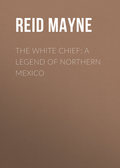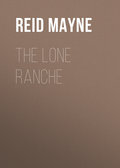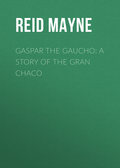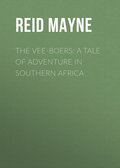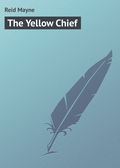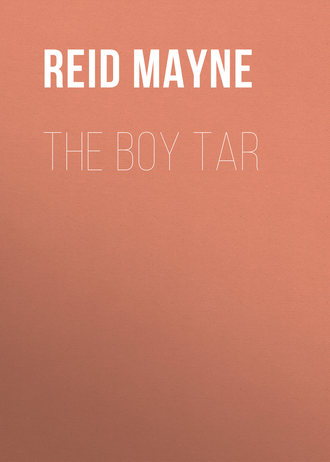
Майн Рид
The Boy Tar
Chapter Twenty Eight.
Going on “Rations.”
I was full of complacence. There was nothing now to cause me uneasiness. The prospect of being cooped up for six months might have been very unpleasant under other circumstances, but after the far more terrible dread of horrid death from which I had just been delivered, it appeared as nothing; and I resolved to bear my long imprisonment with patience and resignation.
Six months I would have to endure this gloomy confinement – six months, at the least. There was but little probability of my being released before the expiration of a half-year: a long term – long and hard to be borne either by captive or criminal – hard even in a lighted chamber, with bed and fire, and well-cooked food, in daily converse with human beings, and the sound of human voices almost continually ringing in your ears. Even with these advantages, to be shut up for six months is a painful experience.
How much more painful would mine be, cramped up in close quarters, where I could neither stand erect nor lie at full length; neither couch, nor fire, nor light to give me comfort; breathing foul air, reclining upon the hardest of oak, living upon bread and water – the simplest diet upon which a human being could exist, and that unvaried by the slightest change, with no sound ever reaching my ear save the almost ceaseless creaking of the ship’s timbers, and the monotonous surging of the ocean wave – certainly six months of such an existence was not a pleasant prospect to contemplate.
Withal I regarded it not. I was still too happy at my deliverance from death, to be nice about the kind of life that was before me, though, as time passed, most probably I should grow tired enough of such a dreary existence.
Now I was all joy and confidence. Not so confident, however, as to rely upon conjecture – upon a mere guess as to the amount of my means of existence. Upon this point I was determined to be fully assured, and that without further loss of time. My stores, both of food and drink, I resolved to submit to actual measurement, in order to be satisfied as to whether they would be sufficient to last me till the end of the voyage.
Hitherto I had felt no apprehension upon this head. Such a large box of biscuit, and such an inexhaustible well of water, could never be expended. This was my first idea; but, after a little reflection, I began to have doubts. The constant drop will wear a hole in the hardest stone, and will also empty the largest cistern, if time be allowed it; and six months was a long time – nearly two hundred days – a very long time.
As I reflected thus, I grew a little uneasy as to the quantity both of my food and drink; and to put an end to all doubt upon the subject, I came to the above determination of measuring them. I recognised the prudence of such a course. If it turned out that there were plenty of both, and to spare, I should no longer be troubled with doubts; and if, on the other hand, there was a danger of either running short, I should then adopt the only precaution possible, and at once put myself on short rations!
When I look back, and think of my cunning at this early age, I am now astonished at it; but it is surprising what forethought even a child will exhibit, when placed in circumstances where self-preservation calls forth all its instincts and energies.
Without more ado, then, I proceeded to make my calculation. I allowed for time, the full six months; or in other terms, a period of 183 days. I did not even subtract the time – about a week, since we had set sail. That I set aside to my advantage, allowing the full period of 183 days, lest I might err by making the time too short. Surely, in six months, the vessel would reach her port, and her cargo be discharged? Surely, I might depend upon this?
No, not surely. I was far from being confident on this head. I knew that a voyage to Peru was usually reckoned a six months’ voyage; but I was not certain whether this was considered the average time; whether it would be accounted a long voyage or a short one; and, therefore, I had no confidence in basing my calculation on such uncertain data.
There was the danger of delay from calms in the tropical latitudes, through which we should have to pass – from storms off Cape Horn, renowned among mariners for the fickleness of its wind – other obstacles might be encountered, and the voyage protracted far beyond the period above mentioned.
I was not without such apprehensions, as I proceeded to examine my resources. To ascertain how long my stock of food would last, was simple and easy. I had only to count the biscuits, and find out their number. I knew their size, and that I could live on two a day, though I was not likely to grow fat on the allowance. Even one a day, or still less than that, would sustain life; and I resolved to be as sparing of them as I could.
I soon ascertained the exact number. The box, as nearly as I could guess, was about a yard long and two feet wide, by about one foot in depth; for I noticed that it was a shallow one set upon its edge. Had I known its exact dimensions, I could have told the number of biscuits without counting them. Each was a little less than six inches in diameter, and of an average thickness of three-fourths of an inch. Therefore, packed as they had been, there would be exactly 32 dozen in the case.
But counting them over one by one was no labour, on the contrary, it afforded pleasure to me; and drawing them forth out of the box, I told them off in dozens. I found that 32 dozen was the number, wanting eight; but the odd eight I was able to account for satisfactorily. I knew where they had gone.
Thirty-two dozen would make 384 biscuits; and, now that I had eaten eight of them, there remained exactly 376; which, at the rate of two per diem, would last for 188 days. True, 188 days would be a little over six months, but as I had not a clear confidence about the length of the voyage being only six months, I perceived that I must go on short rations, of less than two biscuits a day.
What, thought I, if there should be another box of biscuits behind the one I had emptied? That would secure me against all chances, and make my mind easy at once and for ever. What if there should be another? Was it unlikely? No: the reverse. In the stowage of a ship’s hold, there is not much order observed as regards the sort of goods that are placed in juxta-position, but rather is regard paid to the size and shape of the packages; and things of a miscellaneous kind are often stowed together, according to convenience, as the particular piece – whether box, bale, or barrel – may fit into a particular space. Notwithstanding that I knew all this, still it was probable enough that two boxes of biscuits had been placed side by side.
How was I to ascertain? I could not get round the box, even now that I had emptied it; for, as already stated, it blocked up the whole aperture through which I had originally squeezed myself. Neither could I get over the top nor under it.
“Ha!” I exclaimed, as a thought suddenly suggested itself, “I shall go through it.”
The idea was feasible enough. The board which I had already pulled off, left an aperture wide enough to admit my body. This had been part of the top or lid. I could, therefore, get my head and shoulders inside, and with my knife cut a large hole in the bottom opposite. That would enable me to ascertain whether another biscuit-box was beyond.
I was not slow in putting my new design into execution. I first widened a little more the aperture in the top, so that I could work more conveniently; and then I attacked the bottom with my knife. The soft deal yielded pretty freely, but I had not made much progress in this way, when a better plan came into my head. I perceived that the bottom boards of the case were only nailed on – perhaps a little more securely than those of the top, but still not fast enough to resist the blows of a mallet or hammer. I had neither one nor the other, but I thought of a tolerable substitute – my heels. Laying myself, therefore, in a horizontal position, and placing my hands against the great rib to act as a support, I thrust both my feet inside the box. In this position I was able to administer such a series of lusty kicks upon the bottom boards, that one of them soon sprung its nails, and was pressed outward, until I felt it could be driven no farther on account of some weighty impediment beyond.
I now got back to my old position, and examined the progress I had made. I saw that I had dislodged a wide board, so far as the nails were concerned; but it still stood upright, and prevented me feeling what was behind it.
Using all my strength, I succeeded in pressing it to one side and then downward, until an aperture was obtained, through which I could thrust my hands. Sure enough, a box was on the other side – a rough packing-case, resembling that I had just broken through – but whether of like contents had yet to be determined. It would not take long to tell what it contained. I once more exerted my strength, and succeeded in pressing the loose board quite into a horizontal position, so that it no longer obstructed me. The other box was scarce two inches beyond; and falling to upon it with my blade, I soon penetrated through its side.
Alas! my hopes of finding more biscuit were doomed to disappointment. Some woollen substance – either coarse cloth or blankets closely-packed – filled the inside, feeling as solid to the touch as a piece of timber. There were no biscuits there; and I was now convinced I should have to take to the short rations, and make the best of what I already possessed.
Chapter Twenty Nine.
Gauging the Water-Cask
My next operation was to put all the biscuits back into the box, for strewed loosely about as they were, they interfered seriously with the accommodation of my cabin, which by their bulk was diminished more than half. In fact, I had scarce room to turn myself in, so long as they remained outside the case, and I therefore lost no time in restoring them to their former place of deposit. To make the box hold them all, I was obliged to pack them in regular rows, as they had been before; with this difference, that the case having been tilted on its side, the biscuits had been lying with their edges in a horizontal position, whereas I now built them vertically – the proper mode of packing such goods, and the way in which they had been placed when they came from the stores of the baker. Of course, it mattered not which way, as regards the space they would take up. On the flat side, or on their edges, it was all the same; and when I counted in the thirty-one dozen and four odd, the box was full, with only a little empty space in the corner, which the eight missing biscuits had formerly occupied.
So, then, I had taken stock of my larder, and now knew the exact amount of provision I had to depend upon. With two biscuits per diem I could stand siege for a little better than six months. It would not be high living, yet I resolved to do with even less, for I could not feel certain that six months would be the full period of my privations. I formed the resolution to make two a day the rule, and never to exceed that number; and on such days as I felt best able to bear hunger, I should stint my measure a quarter or half a biscuit, or even a whole one, if I found it possible. This economic purpose, if successfully carried out, would throw forward the day of absolute want to a much longer period than six months.
My food being thus rationed out, it appeared equally necessary that I should know the quantity of water I might use each day. To ascertain this, at first appeared to be beyond my power. Apparently I had no means of measuring what remained in the butt. It was an old wine or spirit cask – for such are the vessels generally used on board ships to carry water for their crews – but what kind of wine-cask I could not tell, and therefore I could not even guess at the quantity it might have contained when full. Could I only have established this point, I should then have been able to make a rough calculation as to what had been already spent; rough, but perhaps sufficiently precise for my purpose.
I remembered well the table of liquid measure– I had good reason to remember it – the most difficult of all the tables to commit to memory. I had received many a smart rodding, before I was able to repeat it over; but I at length succeeded in getting it pit-pat.
I knew that wine-casks are of very different dimensions, according to the sort of wine they contain: that under the different names of “pipes,” “butts,” “hogsheads,” “puncheons,” “tuns,” and “pieces,” they hold more or less, from the hogshead of hock of thirty gallons to the great tun of wine containing 252. That the spirits – brandy, whiskey, rum, gin; and the wines – sherry, Port, Madeira, Teneriffe, Malaga, and many other sorts, are transported in casks of different capacity, but usually containing about 100 gallons. I even remembered the number of gallons of each, so well had my teacher – a great statistician – drilled me in “liquid measure;” and could I only have known what sort of wine had once been carried inside of my water-butt, I could have told its measure in a moment. I fancied there was the “bouquet” of sherry about it, and that would have made it a “pipe” of 108 gallons; but it might have been a Madeira pipe, which holds only 92, or Cape, or Marsala, which are about the same size. It might have been Port, which would have stretched its capacity to 115, or a puncheon of Scotch whiskey, some of which contain 120 gallons. I did not think it had been this last, else I should have known the peculiar “twang” which Scotch whiskey gives to water, however diluted it may be. Certainly, there was a perceptible flavour of some liquor, but I was too young to be experienced in drinks, and I learnt nothing from this. No doubt a wine-taster could have told in an instant what sort had formerly filled the barrel, for an old wine-cask will retain the particular “bouquet” of the wine it had carried after performing several voyages as a water-butt.
I drew out the stopper, and tasted the water. I had not thought of noticing its flavour before. It appeared to me to be sherry; but as I have said, it might be Madeira, which would make a difference of sixteen gallons – an important item in a calculation such as I was desirous of making. I therefore could not trust to my judgment to make this the basis of a computation, and I had to think of some other device.
Fortunately in my school arithmetic there were a few hints upon mensuration, and the good master had instructed us in these.
I have often wondered that the simple but useful problems of this branch, of science are so much neglected, while the most useless and irrational rhymes are hammered into the heads of poor unfortunate boys. I have no hesitation in giving my opinion, that a knowledge of simple mensuration, which may be obtained in a week’s study, is of more value to an individual – or to the whole human race, if you will – than a perfect scholarship in all the dead languages of the world. Greek and Latin! These have been very barriers to the advancement of knowledge!
Well, I was saying that my old teacher had taught me a few simple problems in mensuration; and fortunately I still held them in my memory. I could tell the solid contents of a cube, of a parallelopipedon, of a pyramid, of a globe (nearly), of a cylinder, and of a cone. The last was the figure that now interested me.
I knew that a barrel was a pair of cones – that is, truncated cones or frustums– with the bases resting against each other. Of course, when I was taught how to measure a cone, I was also instructed to do the same with the frustum of one.
To ascertain the capacity of my butt, therefore, it was only necessary for me to know its length – or its half-length would do as well – its circumference at either end, and also its circumference around the thickest part or “swell.” These three measurements given me, I could tell to a quart how much water would fill it – in other words, I could calculate how many cubic inches of water it should contain. Knowing this, I should simply have to divide by 69 and a small fraction over, and this would give me the number of quarts, which another simple division of 4 would reduce to gallons, if I required to use this standard.
I perceived, therefore, that if I could get the three measurements, I could soon tell the capacity of my butt; but therein lay the difficulty. How were these measurements to be obtained?
I might have obtained the length, for that was before me from end to end; but how should I get the circumference either of the middle or of either end? I could not reach over the top, nor around the ends. Both directions were blocked up against me.
Another difficulty stared me in the face. I had nothing wherewith to measure them – neither rule nor tape – no standard by which I could determine the number of feet or inches; so that even had all sides been free to me, I should still have been in a dilemma.
I was determined, however, not to yield the point until I had given it a good thinking. The occupation would help me to pass the time; and, as I have already hinted, this was a matter of primary importance. Besides, that faithful old schoolmaster had many a time impressed upon us the valuable truth, that perseverance often finds success where success appears impossible. Remembering this bit of admonition, I resolved not to regard the thing as impracticable, until I had exhausted all my powers of contrivance.
I persevered, therefore, and in less time than I must take in describing it, I hit upon a plan for “gauging” the butt.
Chapter Thirty.
My Measuring-Rule
The details of my plan suggested themselves in the following order: —
While examining the cask, to find if there was not some means of ascertaining its different diameters, I discovered the very way itself. All I wanted was a straight rod or stick, of sufficient length to reach quite across the butt at its thickest part. It was plain to me, that by inserting such a stick into a hole in one side of the cask, and passing it on till it touched the staves on the other side, at a point diametrically opposite, I could thus obtain the exact measurement of the diameter of that part of the vessel, since the portion of the rod reaching from side to side would be the diameter itself. The diameter once obtained, it needed only to multiply by three to get the circumference. But in the calculation which I was desirous of making, it was the diameter itself I wanted to find, and not the circumference. I only thought of the latter, because, under ordinary circumstances, when a cask is bunged up, it is easier to measure the circumference of the swell than its diameter. In no case does it signify which, as the figure three will always reduce the one to the other, near enough for most practical purposes, though not mathematically exact.
Now, it so chanced that one of the holes I had cut through the staves had been made in the very middle of the swell, where the butt was thickest. Therefore a straight stick passed into this hole, and pushed on till it touched the opposite side, would give the greatest diameter of the cask.
You may imagine that this might have been obtained by simply planting the stick in a vertical position outside the butt, and notching it at a point on a level with the top of the vessel. True, this might have been done had I been operating with a barrel lying upon a plain surface, with nothing around it to obstruct me, and plenty of light to observe the true level. Even thus it would have been rough guess work, and not to be depended on when a calculation was to be made involving life or death in its consequences – for such it really did involve – at least, I supposed so. But the butt was so placed, resting upon the timbers of the ship, with its swollen side sunk between them, that I could not have measured it in this manner. Even though I might have marked a rod on a line with its top, I could not have planted the other end so as to be on a level with its base.
There seemed no other way to get at the thing than by inserting a straight stick into the hole, and thus measure the diameter; nor did I trouble myself about any other, as this appeared to be the best plan I could adopt.
Where was I to find my stick – my measuring-rule? That is your question, is it not?
It is easily answered. The deal board that had formed part of the biscuit-box would supply me with the material, and out of that I could soon make one. No sooner thought of than I set about it.
The board was but a little over two feet in length, and of course not long enough to reach across the great cask, which at its thickest part appeared four or five. But a very little ingenuity sufficed to overcome this obstacle. I should only have to split off three thin pieces, and by splicing their ends together, I should get a stick of length sufficient.
I did so. Fortunately, the deal was cut nicely with the grain of the wood; and in splitting it, I guided the blade of my knife so as not to let it run out at the edges.
I succeeded in getting three pieces of the thickness I wanted; and, after shaving off their angles, and making them clean and trim, I cut their ends with a slant for the splice.
The next thing was to obtain two pieces of string, and this was the easiest thing in the world. I wore upon my feet a pair of little “buskins” that laced up to the very ankle. The laces were thongs of calfskin, each of them a full yard long. They were just the thing; and, drawing them out of the holes, I completed the splicing, and now held in my hands a straight stick full five feet in length – quite long enough, I conceived, to reach across the thickest part of the butt, and slender enough to go into the hole – which I had already widened a little to receive it.
“So far good,” thought I; “I shall now insert the measuring-stick, and find my diameter.”
I rose to my feet to carry out this design, but I need not describe the mortification I felt on perceiving that the first of these operations, which would appear to be the simplest of all, could not be performed. At the first trial I saw that it was quite impossible. It was not because the hole was too small, or the stick too large. I had made no mistake about this; but my miscalculation was in regard to the space in which I had to work. Lengthways my little chamber was nearly six feet, but crossways little more than two; and up where the hole was – in which I intended to insert the measuring-rod – it was still less. Of course to get the stiff piece of stick into the cask was plainly impossible – without bending it, so that it must break – for the dry deal would have snapped through like the shank of a clay pipe.
I was a good deal chagrined at not having thought of this before; but I was still more vexed at the idea of being obliged to abandon the design of making the measurement I had intended, for before reflecting I believed that this was to be the result. A little further consideration, however, helped to a new plan, proving the importance of not arriving too hastily at conclusions. I discovered a way of getting in the stick to its full length, without either breaking or bending it.
This could be effected by taking it to pieces again, then first inserting one of the pieces, and holding it till the second could be spliced on to its end, and then pushing both into the cask, and joining the third piece in a similar fashion.
About this there appeared no difficulty, and the result proved there was none; for in less than five minutes after conceiving it, I had carried the design into execution, and the measuring-rod stood inside the barrel, with one end projecting some inches on the outside.
Holding this end carefully in my hand, I caused the other to play about on the opposite side, until I felt convinced that it touched the point that was exactly vis-à-vis with the aperture; and then steadying the stick, I notched it with my knife, on a level with the outer surface of the stave. To calculate from this notch would not be correct, as it would be more than the diameter of the cask – that is, in reference to what it would contain – but I had no intention of doing so. I should make allowance for the thickness of the stave, and that would give me the measurement I wanted.
Having made my mark, I drew forth my measuring-rod, piece by piece, as it had been plunged in. I took care as I did so to notch both the splices, so that I might be able to put them together again in the exact place where they had been while making the measurement. All this attention to such minute particulars was of importance, and I knew it to be so, for the mistake of even a quarter of an inch in the length of my diameter would cause a difference of many gallons in the result. Most certainly, then, was it of consequence that I should be precise in my data.
I now had the diameter of the swell; the next thing was to get that of the head, or end. About this there was less difficulty – in fact, not any. It was obtained in a few seconds.
Though I could not myself get round either of the ends of the butt, nor even my arm, I could pass the rod around them, and in this way measure them. Even had there not been space to admit the measuring-stick, I should have found a means – by simply drilling another hole with my knife, close to either end, and gauging as before. But this would have occupied time, and it was not necessary to do so, since the stick passed along the head of the butt without any obstruction, till its end rested against the projecting rim on the opposite side. I had nothing to do but assure myself that its point was fair in the middle, and then make my mark as before.
The length of the butt was yet to be ascertained; and this, though apparently a simple operation, cost me a good deal of consideration, before I could get at it with any degree of exactness. You may fancy that it would have been easy enough to get at the length, by just placing the stick parallel to the cask, and notching it square with the ends of the latter? And so it might be easy enough, with plenty of light around you to see when it was square, and a level surface upon which to rest your measure. But as I had the advantage neither of light nor level ground, I encountered great difficulty in this operation. I could not tell when the ends lay even with each other, merely by the touch. I had to pass my fingers from one to the other, and could not grasp both at one time – that is, the rim of the cask and the end of the rod – since they must needs be several inches apart. The stick, too, lay unsteady, and by the feel I could not be sure when its end was exactly “flush” with the head of the cask. The mistake of an inch – it might be several – would falsify all my computations, and render them of no use. It would not do to proceed upon such a conjectural basis, and for a while I was puzzled, and had to pause.
This was an unexpected obstacle, for I had from the first regarded the diameters as the only difficulty; about the possibility of obtaining the length, I had never entertained a doubt.
But my wits again came to the rescue, and I soon discovered a plan that would effect the end in view. I had to make another rod – by splicing two more lengths split from the board – and with this I was able to determine the point.
I managed the matter thus: The old rod I pushed along the head of the cask quite beyond its outer edge, so that it rested at both ends against the projecting rim. Thus placed, it was exactly parallel with the plane of the barrel’s head, while a foot or more projected outward and towards me. Holding the end of the second rod against this projecting part, and at right angles, I gave it a direction along the side of the cask, and I was able to mark the point, where the middle part of the swell came in contact with the second rod. This, of course, after deducting the depth of the rim and the presumed thickness of the head, gave me half the length of the interior of the cask, and that was all I wanted, since two halves make one whole.
I was now in possession of the data of my problem; it only remained for me to seek the solution.



